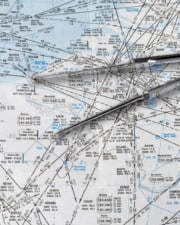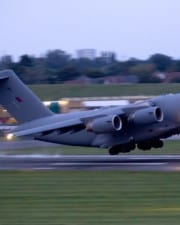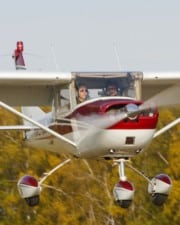One of the mystical things about airplanes is autopilot. We hear about it in movies, and we know it’s there, but what does it do and how does it do it? When you’re on an airliner, how much of the time is the pilot flying the plane?
Table of Contents
What is Autopilot?
Autopilots are pretty simple devices that control the flight controls of the aircraft. That way, the pilots don’t have to physically fly the aircraft for the entire flight. They still have to observe and ensure that the autopilot performs correctly and like they expect it.
How Does the Autopilot Work on a Plane?
Autopilots have been around for decades, and while they keep getting better and better, most older systems still work fine. These systems vary considerably in complexity, from simple one-axis controllers that keep the wings level to sophisticated devices on airliners that can navigate a complicated course and sometimes even land the plane!

In airliners, the autopilot controls are usually located along the top of the glare shield panel.
Autopilots are categorized based on how many controls they are coupled to. The most basic units are one-axis autopilots, which only control roll. Nicer units control two-axes–roll and pitch.
Wing Levelers
The most straightforward systems are called wing levelers. As the name suggests, they have only one function–to keep the wings level. Even this is usually sufficient to reduce a significant portion of the pilot’s workload.
Wing levelers are useful only when the pilot is very good at getting an airplane trimmed for level flight. With the elevator trim tab’s help, most planes require very little input to remain at altitude. Roll requires more correction, however, so a wing leveler can come in handy.
Two-Axis Systems
Two-axis systems provide a lot more options and a lot more hands-off flying time for the pilots. They also offer the ability to be coupled with some types of instrument approaches.
Notice that neither system controls the airplane’s rudder. Since the rudder requires very little input during cruise flight anyway, it’s not worth the expense and effort of adding the control to the rudder pedals.
Most pilots will be resting their feet on the pedals regardless of whether or not the autopilot is on. Applying a little bit of rudder pressure will be their natural reaction, whether the computer or the pilot rolls into the turn.
There are three-axis systems out there, but they’re usually reserved for airliners and large transport-category aircraft.
Roll and Pitch Control
To control roll, a servo motor is mounted that moves the control stick or wheel inside the aircraft. The autopilot controls the roll of the aircraft with the ailerons, just like the pilot would.
The pitch of the plane is controlled via the trim tab. Since the trim tab moves the larger elevator, this is an easy indirect way to control pitch without having to make a mechanical linkage to move the control yoke.
Autopilot-equipped aircraft usually also have electric trim wheels. A servo motor will spin the trim wheel up and down. This system is how the autopilot controls the aircraft’s pitch, but the pilot can also use the electric trim during normal flight.
Electric trim is nice to have on any plane. It means that the pilot can simply move a toggle switch with their thumb, right on the control wheel, instead of moving the much larger trim wheel. The trim wheel is still there, and it can be moved manually if desired.
Two Vital Components
There are two vital components to any autopilot system in the cockpit. One is a disconnect switch. It’s so important that it is usually located right on the control wheel at the pilot’s thumb. It can be deactivated with a second’s notice.
Another important control is the circuit breaker that will disconnect all power from the autopilot system.
Why are these safety cutoff features important? Autopilots are computerized systems that can–and do sometimes–go haywire. The pilot needs to be able to disconnect the system and take over manually flying the plane in an emergency. If the autopilot starts acting unexpectedly or putting the aircraft into a dangerous flight attitude, the pilot needs to be able to take immediate action.
Electric trim systems have been known to enter runaway situations, where the button gets stuck or the wiring shorts out. In this case, the plane will pitch up or down dangerously. Pulling the circuit breaker for the autopilot system will remove all power from the trim as well.
Autopilot Basic Modes of Operation
ROLL Mode
An autopilot’s most basic mode is “ROLL,” which keeps the wings level. Most units can also hold a heading (HDG) or a navigational radio course (NAV).
Heading Hold Mode (HDG)
The heading hold mode is controlled by a settable bug on the directional gyroscope. This instrument is right in front of the pilot, and it’s where the pilot would look to figure out their heading anyway. The pilot sets the heading they want to fly, and the autopilot will track that heading if the HDG mode is selected.
Navigational Mode (NAV)
The navigation function gives the autopilot a lot more authority. It is usually tied to the NAV1 indicator, so whatever navigational radios work there will be coupled into the autopilot. On most aircraft, this includes the first VOR navigation radio and the GPS. Whatever course the pilot has selected there, the autopilot will keep centered.
Combined
The two modes can be combined for simple flight tasks. For example, it’s not uncommon for a plane to be given a heading to fly until they can join a VOR course. In this case, the autopilot can be operated in HDG mode with the NAV mode armed. The autopilot will watch the navigational course, and as it comes into view, it will command a slow turn to join that course.
If a two-axis autopilot is installed, it holds its altitude based on an altitude that the pilot sets. ALT mode indicates that the autopilot will hold that altitude. Since the autopilot’s altimeter is built-in and not the one used by the pilot, the current barometer setting must be input to the autopilot as well.
These systems are usually advanced enough to allow the pilot to change altitudes without touching the flight controls. If a descent is desired, then the pilot changes the selected altitude on the autopilot. The autopilot then switches into a vertical speed hold mode, which the pilot can fine-tune to their liking. The computer arms the ALT hold mode and waits until it reaches the selected altitude, where it levels off.
Of course, during the level-offs, the autopilot cannot change the throttle setting. So the pilot must still make power adjustments, just like they must still make rudder inputs.
Flight Management System (FMS)
More technically advanced aircraft have some form of a system known as FMS, or flight management system.
On airliners and transport-class airplanes, the FMS is usually the primary location where pilots input their navigational planning. The FMS is tied to all other systems, so ideally, it simplifies the use of multiple navigational services while in the air. It talks to the GPS unit, the VOR radios, the ADF radio, and the INS (inertial navigation system) if installed.

All of this makes a powerful unit that gets a lot of pilot attention. But the primary function of FMS is to layout the flight course in advance. If your flight path takes you over the ABC VORTAC, then the XYZ VORTAC, and then to intercept the I-ILS instrument approach, the computer can be set up to do all of those things before the plane even takes off.
That capability is found in many aircraft today, even light aircraft. Modern GPS systems and glass cockpits allow the pilot to have FMS-like control over the plane’s course. The result is that a course line is predefined in the computer systems before departure, which reduces workload from the pilot and enables them to use the autopilot to fly that course.
Automation Management Training
If all of this sounds more like computer programming and less like flying an airplane, you’d be right. All of this head-down time comes at a price for pilots, who now have a lot more to do inside the cockpit.
The art of dealing with all of the fancy computers, autopilots, and FMS systems is known as automation management. It’s now a vital skill for pilots to build.
It might seem to a non-flyer that pilots must be very good at multitasking and dividing their attention. But research has shown that the human brain is extremely bad at multitasking. We think we are good at dividing our attention equally, but what really happens is that we are not focused on anything very well.

Pilots know their limits, and while it may look like they’re multitasking, what they are doing is effectively managing their time. When workload is light, like on the ground before departure or during quiet cruise flight, they are preparing for busy parts of the flight they know are coming.
In the end, this is the beauty of autopilot. The pilot must still monitor an autopilot system at all times. But they do not have to make the control adjustments for every gust of wind or every course change. That frees up some of their mental resources to deal with other issues.
If you see a pilot with their head down programming a computer or dealing with the FMS, chances are they are preparing for an upcoming phase of flight when they know they will be task saturated. For example, takeoffs, departures, approaches, and landings are times when they will have too much to do and cannot spare the attention required to mess with the computers.
How Much of a Flight is on Autopilot?
On a commercial airliner, nearly the entire flight is flown on autopilot. The pilots continuously monitor the computer to ensure that it follows the correct programmed course and make sure that all of the programming is in order.
Autopilot systems cannot takeoff, so taxi, takeoff, and other ground operations are done manually. The autopilot is usually engaged a few hundred feet off of the runway after departure.
When arriving at an airport, the autopilot is usually used until the very last segment of the approach. When the runway is in sight, the pilot flies the plane to the landing.
Do Airplanes Land on Autopilot?
Some planes do have autoland systems, but these are generally only used in poor visibility when they must be used. With a certified autopilot, some airplanes can land after an instrument approach in zero-visibility conditions.
None of this is to say that some pilots don’t like to hone their skills and take manual control of the plane from time to time. Sometimes a pilot may take manual control and fly the plane to their cruising altitude, or fly an entire instrument approach. They do it for proficiency, but they also do it because they love it.
Related Posts













